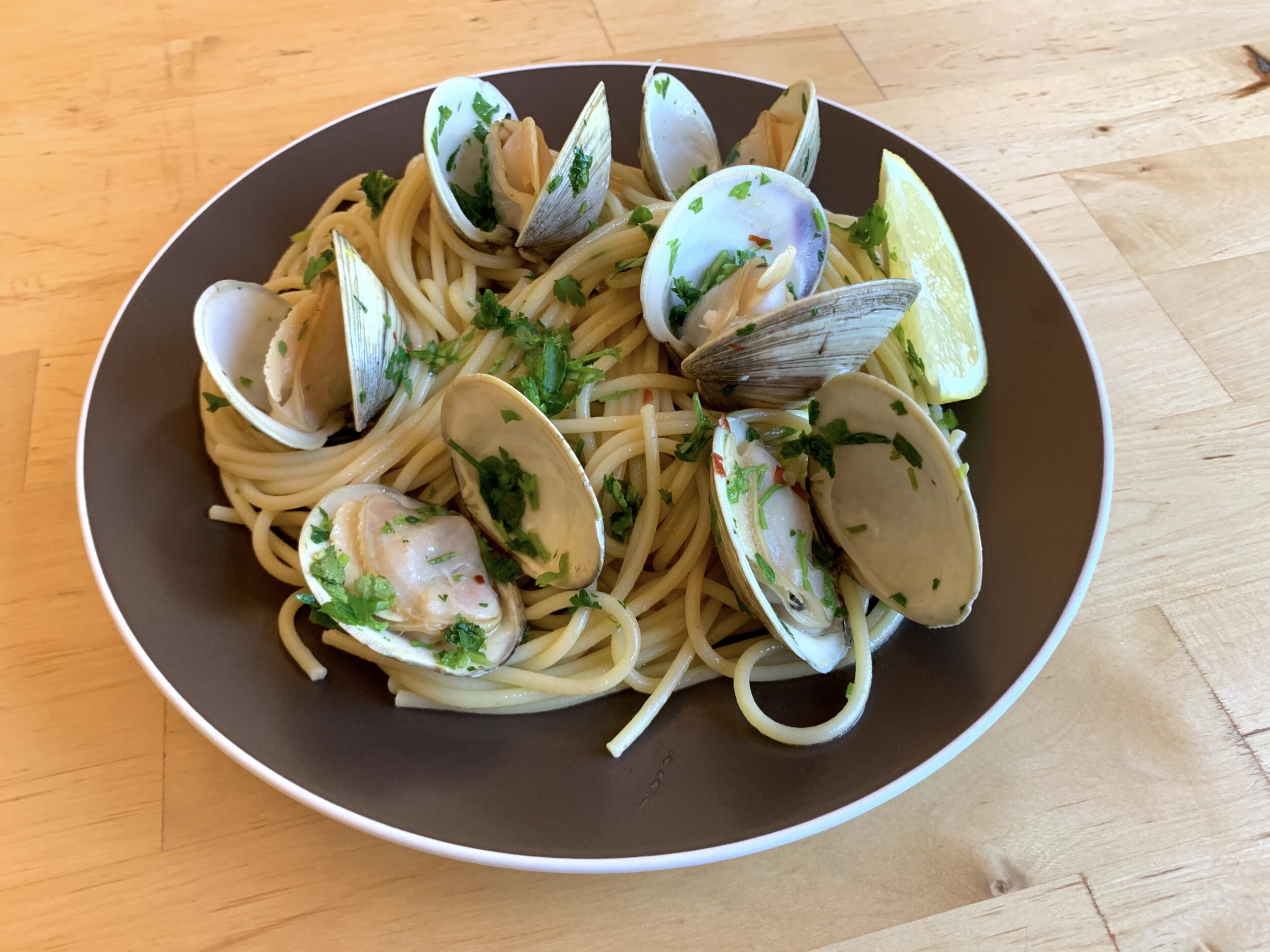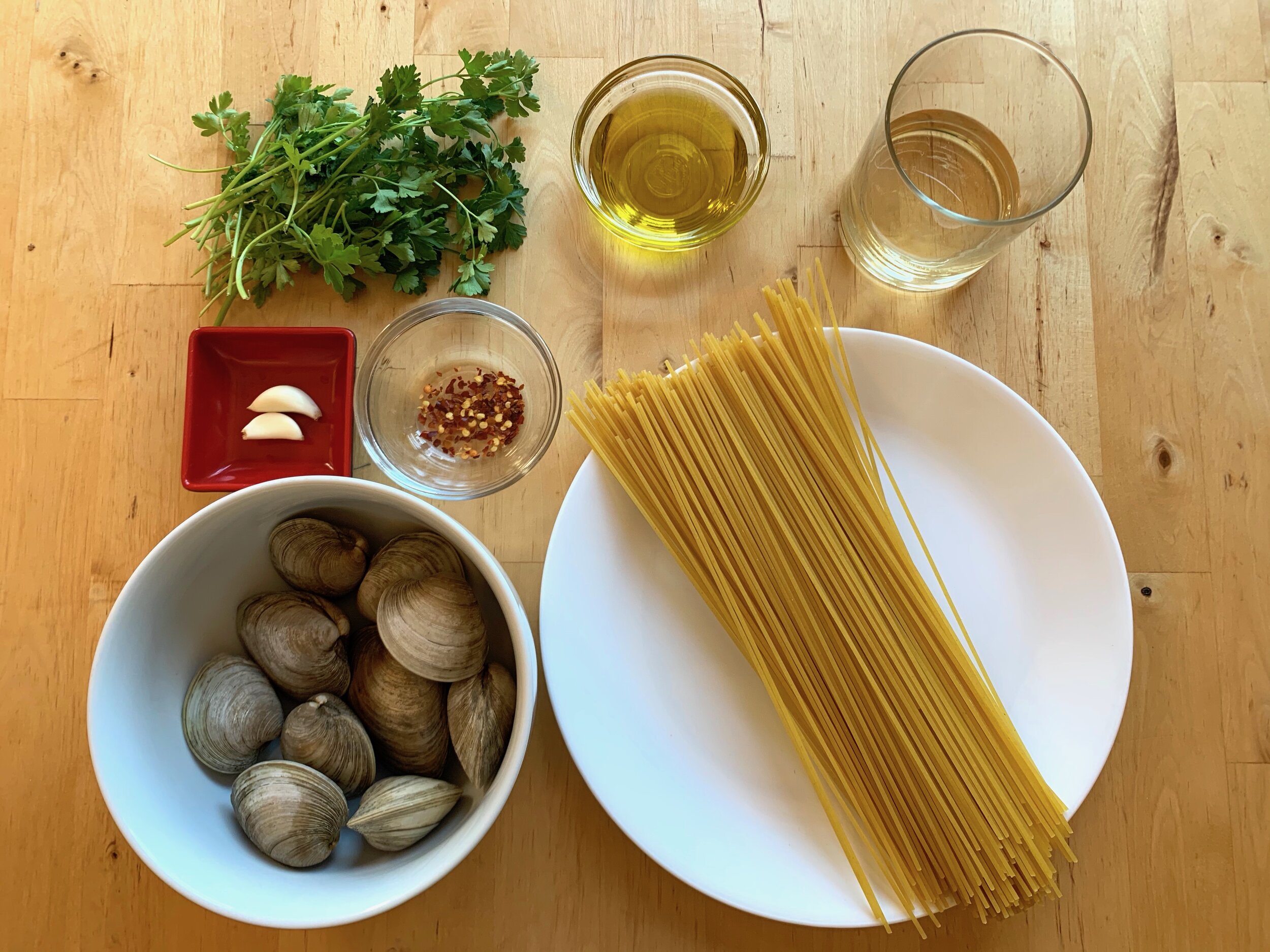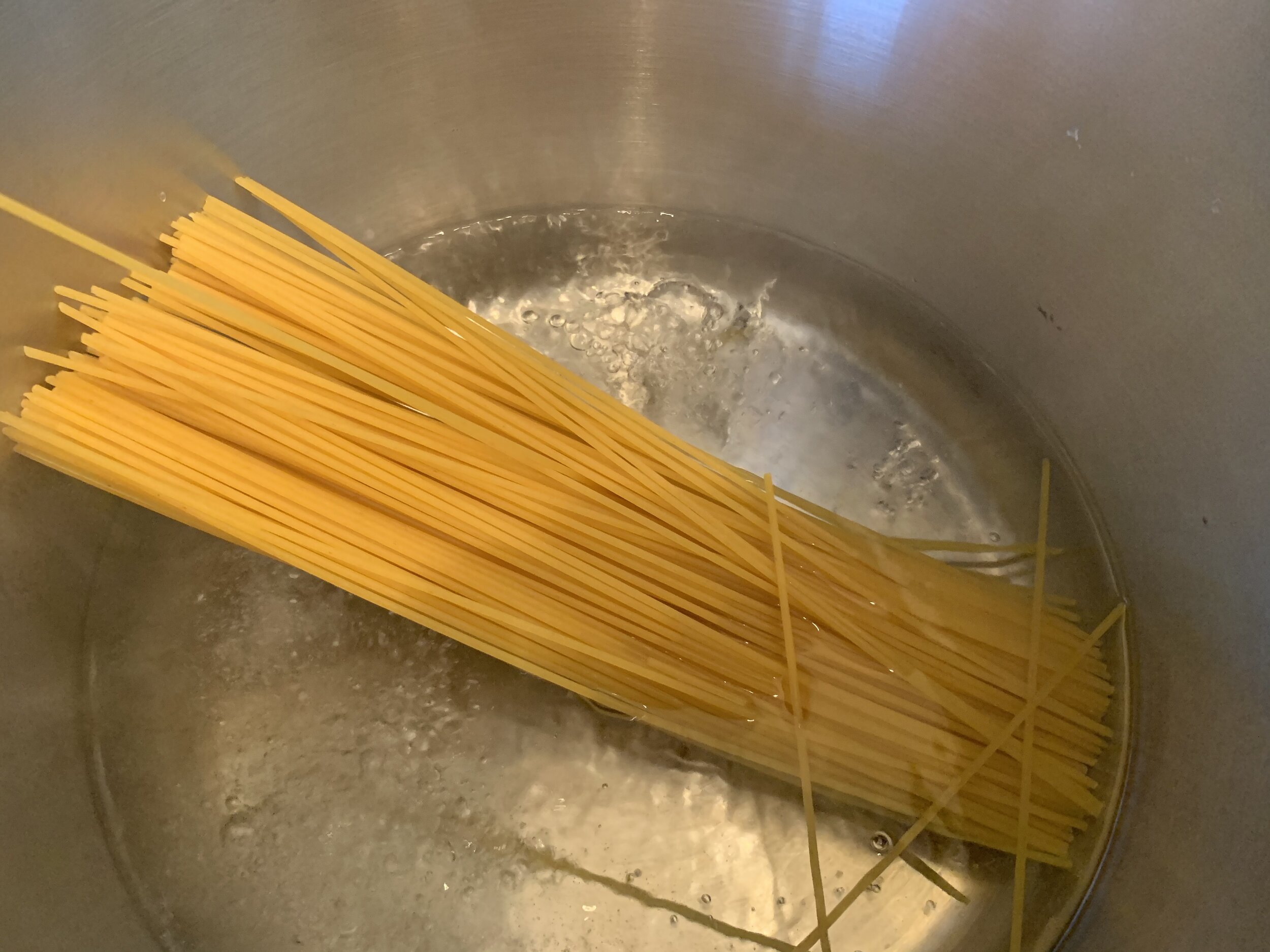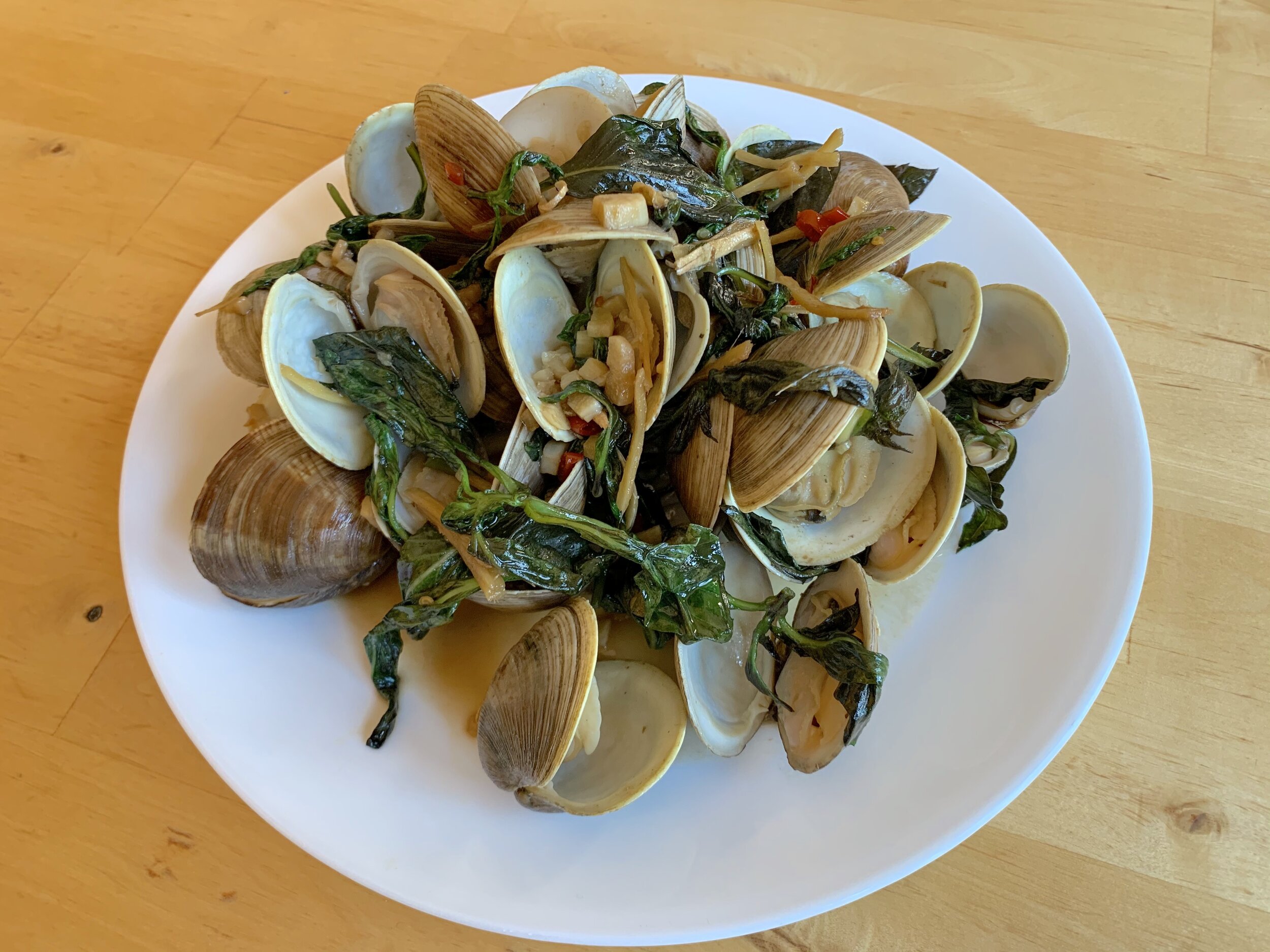Spaghetti alle Vongole

Spaghetti alle vongole originated in the city of Naples, on the Italian coast. Clams have formed a part of the local diet since ancient times, so it is perhaps no surprise that a clam pasta dish also originated in the city. The first recorded recipe for what we now recognize as spaghetti alle vongole appears in the cookbook Cucina Teorico-pratica, written by Ippolito Cavalcanti, the Duke of Buonvicino, in 1839. His recipe called for just five ingredients—pasta, olive oil, garlic, parsley, and, of course, fresh clams. While a handful of ingredients have since crept into the dish in Naples, most notably white wine and red pepper, spaghetti alle vongole has changed remarkably little in the intervening years. The version of this dish we will be preparing today cleaves pretty closely to the modern “in bianco” preparation of spaghetti alle vongole, not very far from Cavalcanti’s recipe.
Ingredients
1.5 small manila or littleneck clams, cleaned
½ lb spaghetti
1 bunch Italian parsley, chopped
2 tbsp olive oil
1 tsp crushed red pepper
2 cloves garlic, sliced
½ cup white wine
Salt to taste
In Naples, spaghetti alle vongole was historically made with a small clam known as vongola verace, [1] but any species of clam will work in this dish, so use whatever is available fresh in your region. Look for small clams, which are more tender than their larger brethren. Before we discuss cooking, a quick word on storing and cleaning clams. Like most bivalves, clams need to be kept alive before cooking—dead clams will go bad quickly. Because of this, it is best to cook clams the day they come home from the store. If that isn’t possible, you can hold clams for up to 2 days in the refrigerator by keeping them in an open container covered with a damp paper towel. The container must be open to prevent the clams from suffocating, and the damp paper towel will prevent them from drying out.
At most grocery stores, clams sold loose in the case are already cleaned. However, clams still in the bag likely have not been. Clams live in the sand of the seabed, and feed by filtering microorganisms out of the seawater. Because of this, sand and other debris often sticks to the outside of the shell. Additionally, the clam will ingest some sand as it feeds, resulting in grit inside the clam. No one likes getting sand in their food, so if your clams have not yet been cleaned, you will have to do it at home. The first step to cleaning a clam is purging the guts of grit. The ideal way to do this is to place the clams in a bucket of cold, clean seawater for a few hours, and let them expel the grit on their own Clams kept in seawater can stay submerged for up to a day. However, as most people do not have access to seawater, you must do your best to replicate seawater at home. We can do this by mixing cold water with sea salt, at a ratio of 1 tablespoon salt to 2 cups water. Place the clams in this solution for 1-2 hours to let them expel the grit. Do not use fresh water, which will kill the clams. The clams are unlikely to survive for too long in the salt water, so do not keep them submerged for longer than 2 hours.
As you remove clams from the solution, scrub the shells with a clean and sturdy brush to rid the shells of any sand or mud. While you scrub, look out for any open clams. Clams which are alive and healthy should be tightly shut. If a clam is open, give it a strong tap on the shell. If the clam doesn’t immediately close, it’s probably dead. Throw it out.
Begin by bringing a large pot of salted water to a boil. We will be simultaneously cooking the two time-sensitive components of this dish—pasta and clams—so while the water comes up to temperature, do your mise en place: thinly slice the garlic and chop your parsley. When the water comes to a boil, add half a pound of spaghetti to the pot and cook until the pasta is about 2 minutes from tender, a stage known as al chiodo. For most spaghettis, this should take about 8 minutes. We will be finishing the pasta in the clam cooking liquid, where it will absorb plenty of clam flavor.
While the pasta cooks, we will get ready to cook the clams. The clams will cook mostly by steaming, so we want to use a pot with a tight-fitting lid for this dish. Heat 2 tablespoons olive oil in the pot over high heat, and add the sliced garlic and crushed red pepper to the pot. Fry for about 30 seconds, stirring occasionally, until the aromatics become fragrant.
Add the clams to the pot, pour over ½ a cup of white wine, and immediately clamp on the lid—the wine should almost immediately start to produce steam. The clams should cook in 3-5 minutes, depending on their size. Shake the pot occasionally to toss the clams without opening the lid.
There is nothing worse than an overcooked, rubbery clam. Because clams are so lean, even an additional minute under heat will cause the clam to become tough. No matter how close in size your batch of clams are, there will always be some variation, with the smallest clams likely to be done first. Therefore, to avoid overdone clams, we have to pull each individual clam out of the pot as soon as its done cooking, rather than wait for the entire batch to be done. Fortunately for us, clams have a built-in doneness indicator—when a clam is cooked, it opens! [2] Have a large bowl standing by to hold the cooked clams, and once the clams have been in the pot for 3 minutes, start checking. Open the lid, quickly remove any open clams to the bowl, and then close the lid again. Repeat this process every 30 seconds, removing the clams as they finish cooking, until all the clams are cooked.
By the time the clams are all done, the pasta should be nearing al chiodo, a couple of minutes shy of al dente. The clam cooking pot should now be empty of clams, and contain just the clam juices and wine. Drain the pasta, and add it to the clam cooking pot, along with ¼ cup of the starchy pasta water. Bring the clam cooking liquid back to a boil, and cook the pasta until al dente, about 2 minutes. Toss occasionally to coat the pasta in the thickening sauce. If you need to loosen the liquid, add a bit more of the pasta water to the pot. Once the pasta is cooked, return the clams to the pot, together with any juices that have collected at the bottom of the bowl. Throw in the chopped parsley, turn off the heat, and toss to combine. Salt to taste, remembering that the clam juices are naturally salty. Serve immediately, with an optional lemon wedge if desired.
Substitutions
Other long, narrow pasta shapes such as vermicelli and linguine work in this dish. Feel free to add a handful of halved, ripe cherry tomatoes to the pasta. This will turn the dish into spaghetti alle vongole “in rosso.” If you prefer a spicier dish, increase the amount of crushed red pepper, or add some Calabrian chilies.
A crunchy breadcrumb topping is a nontraditional addition that plays well with the clams. Melt some butter in a pan, and crisp up some coarse breadcrumbs with some minced garlic and parsley. Sprinkle these breadcrumbs over the pasta for some added texture.
If you can’t get your hands on fresh clams, you can substitute them for canned clams and a splash of clam broth, but unfortunately, it won’t be quite the same.
[1] Vongola verace, which translates to “genuine clam,” originally referred to the species Venerupis decussata, a small clam native to the Mediterranean. However, this clam has become rare in Italian waters due to overfishing. The Pacific manila clam (Ruditapes philippinarum) was seeded in the Adriatic Sea for cultivation, and the Italian clamming industry successfully lobbied for a law to be passed in Italy declaring that manila clams could also be marketed as “vongola verace.” Ironic, right?
[2] Why do clams open when cooked? When a clam is alive, it opens and closes its shell often—to feed, to dig, to defend itself against predators, or to prevent drying out if exposed to air. As muscles are only capable of contracting, a clam can use a muscle (the abductor muscle) to close its shell, but cannot use one to open its shell. Instead, evolution has crafted bivalve shells to have an elastic hinge ligament which “spring-loads” the shell. A clamshell will open on its own, unless a muscle is contracted to pull it shut. When a clam is cooked, the proteins of the abductor muscle denature, causing the muscle to release its grip. The shell then opens on its own due to the elastic hinge.
Recipe
Prep Time: 10 min Cook Time: 10 min Total Time: 20 min
Difficulty: 3/5
Heat Sources: 2 burners
Equipment: 2 pots
Servings: 2
Ingredients
1.5 small manila or littleneck clams, cleaned
½ lb spaghetti
1 bunch Italian parsley, chopped
2 tbsp olive oil
1 tsp crushed red pepper
2 cloves garlic, sliced
½ cup white wine
Salt to taste
Instructions
1. Bring a large pot of salted water to a boil. Add the spaghetti and cook for about 8 minutes, until 2 minutes before tender.
2. Meanwhile, heat 2 tbsp olive oil in a pot over high heat, and add the garlic and red pepper to the pot. Fry for 30 seconds, until fragrant.
3. Add the clams to the pot, and pour over the white wine. Immediately clamp on the lid and steam for 3-5 minutes, shaking the pot occasionally to toss the clams.
4. As soon as a clam opens in the pot, it is cooked. Each clam will cook in a slightly different time, and keeping a clam on the heat after it has opened will result in that clam becoming overcooked and rubbery. From 3 minutes onwards, check the pot every 30 seconds for open clams, and remove the cooked clams to a large bowl. Continue cooking, removing the clams as they finish cooking, until all the clams are cooked.
5. When the pasta is 2 minutes away from tender, drain it and add it to the pot of clam cooking liquid, together with ¼ cup pasta water. Cook the pasta in the pot over high heat, tossing in the cooking liquid until al dente, about 2 minutes.
6. Return the clams to the pot, together with the chopped parsley, and toss to combine. Serve immediately.
















